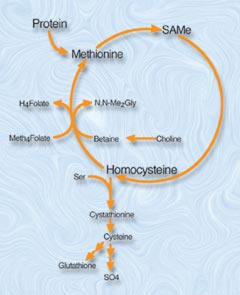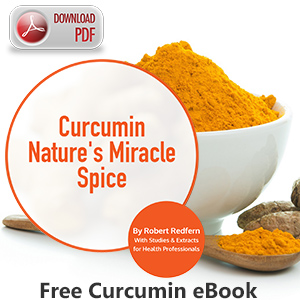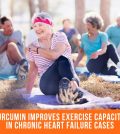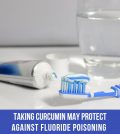Curcumin’s Anti-Cancer Effects
![]() Imagine a natural substance so smart it can tell the difference between a cancer cell and a normal cell; so powerful it can stop chemicals in their tracks; and so strong it can enable DNA to walk away from lethal doses of radiation virtually unscathed. Curcumin has powers against cancer so beneficial that drug companies are rushing to make drug versions. Curcumin is all this and more.
Imagine a natural substance so smart it can tell the difference between a cancer cell and a normal cell; so powerful it can stop chemicals in their tracks; and so strong it can enable DNA to walk away from lethal doses of radiation virtually unscathed. Curcumin has powers against cancer so beneficial that drug companies are rushing to make drug versions. Curcumin is all this and more.
Curcuma longa is a ginger-like plant that grows in tropical regions. The roots contain a bright yellow substance (turmeric) that contains curcumin and other curcuminoids. Turmeric has been used in Ayurvedic and Chinese medicine for centuries. But it’s only within the past few years that the extraordinary actions of curcumin against cancer have been scientifically documented. Among its many benefits, curcumin has at least a dozen separate ways of interfering with cancer.
Curcumin blocks estrogen mimicking chemicals
One of the things that sets curcumin apart from most other anti-cancer supplements (I3C being an exception), is that this phenolic can actually block chemicals from getting inside cells. Importantly, curcumin can interfere with pesticides that mimic estrogen. These include DDT and dioxin, two extremely toxic chemicals that contaminate America’s water and food. (Dioxin is so toxic that a few ounces of it could wipe out the entire population of New York City). Curcumin has the unique ability to fit through a cellular doorway known as the aryl hydrocarbon receptor. This is a feat it shares with estrogen and estrogen-mimicking chemicals. Because it can compete for the same doorway, curcumin has the power to block access to the cell and protect against estrogen mimickers.
Like estrogen, estrogen-mimicking chemicals promote the growth of breast cancer. In a study on human breast cancer cells, curcumin reversed growth caused by 17b-estradiol by 98%. DDT’s growth-enhancing effects on breast cancer were blocked about 75% by curcumin.
Two other estrogen mimickers were tested for their ability to enhance breast cancer. Chlordane and endosulfane together make breast cancer cells grow about as much as17b-estradiol. Curcumin can reverse that growth about 90%. Adding the soy phytochemical, genistein, causes a 100% growth arrest.
Curcumin’s ability to block other chemicals have been documented. It has been tested against paraquat (weed killer), nitrosamines (in cooked meat and “lunch” meats) and carbon tetrachloride (a solvent in varnish and other products). In all cases, curcumin is able to block the chemical’s effect. The beneficial effects are evident in a study where mice were treated with diethylnitrosamine. All mice treated with this chemical would usually develop liver cancer. However, when treated with curcumin, the percentage of animals developing cancer went from 100% to 38%, and the number of tumors dropped by 81%.
Drug companies rush to make synthetic versions
One of the hottest areas of oncology drug development is in the area of kinase inhibitors. Kinases are the equivalent of phone lines into cancer cells. There are over 2000 known protein kinases, or phone lines. These lines run from the outside of a cell into the DNA command center. They carry messages. Cut these lines, and you can effectively stop the growth of some types of cancer cells.
Curcumin effectively blocks some of the lines. In cells treated with curcumin, certain “grow” signals are blocked from reaching the cell.
The most well-studied growth factor blocked by curcumin is nuclear factor-k B. NF-kB is activated by chemical messengers known as cytokines. Cytokines help the immune system, but they also activate signals that tell cells to multiply, grow. By interfering with those signals, curcumin effectively stops the growth of cancer cells by kinase pathways. It has been demonstrated, for example, that curcumin can prevent the bug that causes ulcers (Helicobacter pylori) from causing cancer. H. pylori increases levels of a cytokine (IL-8) that activates NF-kB. Curcumin blocks the process.
Drug companies are rushing to patent chemicals that do what curcumin does-inhibit kinases. AstraZeneca has gotten one off the ground called “Iressa”. Iressa inhibits protein kinase C (PKC), a kinase that plays a significant role in cancer. PKC transmits signals from the “epidermal growth factor (EGF) receptor.” Cutting off signal transmission through EGF significantly slows the growth of any cancer that uses this factor to grow-glioma, breast, prostate, skin and lung cancers.
Curcumin has long been known for its ability to prevent skin cancer. In 1993, researchers in Taiwan reported that curcumin inhibits PKC. The next year it was reported that curcumin blocks EGF signals up to 90% and stops growth.
It turns out that the structure of curcumin enables it to inhibit multiple kinases. This ability is shared with other phytochemicals including silymarin, apigenin and hypericin. While drug companies rush to try to recreate safe, patentable, chemical versions of this structure, curcumin sits ready and available for use. Blocking kinases, however, is only one of curcumin’s anti-cancer effects.
Inflammation: Curcumin suppresses LOX and COX
Squamous cell carcinoma can affect the bronchial tubes, mouth or skin. When researchers at the University of Missouri treated oral squamous cell carcinoma cells with curcumin, it caused significant growth inhibition.
Curcumin is also notably effective against colon cancer. Inflammation appears to play a significant role in promoting this type of cancer. Curcumin has long been known for its anti-inflammatory action. More recently, it has been shown that curcumin inhibits cyclooxygenase (COX) and lipoxygenase (LOX), two enzymes that promote inflammation. Inflammation is in the limelight these days because of the discovery that people who take nonsteroidal anti-inflammatory drugs (NSAIDs), including aspirin, have stunning protection against colon cancer. Inflammation, it turns out, plays significant and diverse roles in the initiation and promotion of cancer. Oxidative stress helps activate PKC, for example. Part of curcumin’s ability to block PKC signals is due to its powerful antioxidant activity.
Curcumin possesses several other anti-cancer benefits that make it useful for cancer prevention. One of its most recognized features is its antioxidant action. Turmeric is a spice that contains curcumin. It has traditionally been used as a food preservative for a good reason: it keeps food from going rancid-oxidizing. And just as it keeps oxygen from turning meat rancid, it protects our own bodies from damaging free radicals. Free radicals promote cancer by damaging DNA and activating genes.
Radiation damages DNA partially through free radicals. In a recent study, it was demonstrated that under laboratory conditions, curcumin could protect bacteria from a lethal dose of radiation almost perfectly. Bacterial DNA emerged virtually intact.
Curcumin kills cancer cells
Curcumin can stop cancer in its earliest stages, long before it’s detectable. It works at the level of the cell. One of the things it does is to tell damaged cells to self-destruct so they won’t keep multiplying. The process is called “apoptosis” and it’s the body’s way of destroying abnormal cells that can become cancerous. Cancer cells can circumvent the process, but curcumin can override them and send “self-destruct” signals to many different types of cancer cells. Curcumin does not induce apoptosis of healthy cells, only cancerous ones. It identifies cancer cells by their abnormal chemistry. Unfortunately, it doesn’t work in all types of cancer, but Indian researchers may have figured out why. Their findings, published in the Journal of Biological Chemistry, may lead to ways of making most types of cancer susceptible to curcumin’s effects.
Before apoptosis is induced, curcumin stops cancer cells from multiplying. In cancer research, this is known as “interrupting the cell cycle.” The cell cycle can be interrupted at several different points. This is the rationale behind using various chemotherapy treatments in one person. One drug stops the cells when they are in one stage of growth; another stops them at another stage. Using a variety of drugs that stop growth at different stages increases the chances of killing all the cancer cells. Curcumin arrests the growth of cancer cells in the G2 stage.
 |
Curcumin,
|
Other phytochemicals stop the cell cycle at other stages. Genistein, a soy phytochemical, arrests growth at G2, like curcumin. But epigallocatechin-3-gallate (EGCG) from green tea, arrests cancer cell growth at the G1 phase. Combining EGCG with curcumin increases the odds of killing more cells. Researchers at Sloan-Kettering Cancer Center have suggested that EGCG and curcumin be used together for cancer prevention.
Curcumin enhances immunity
Curcumin can also help the body fight off cancer should some cells escape apoptosis. When researchers looked at the lining of the intestine after ingestion of curcumin, they found that CD4+ T-helper and B type immune cells were greater in number. In addition to this localized immune stimulation, curcumin also enhances immunity in general. Researchers in India have documented increased antibodies and more immune action in mice given curcumin.
Curcumin stops angiogenesis
All of the above actions of curcumin stop cancer before it has a chance to become detectable. If cancer grows to the point that it is a detectable tumor, curcumin can still have an effect.
Certain enzymes enable tumors to create a blood supply for themselves. Known as “angiogenesis,” this phenomenon allows tumors to invade surrounding tissue and spread. Working with blood vessels of the eye (where angiogenesis creates big problems for vision), researchers at Tufts University were able to inhibit blood vessel formation by using curcuminoids. Curcumin blocks AP-1, which enhances angiogenesis.
Curcumin may also inhibit angiogenesis by chelating metals used by enzymes that promote the growth of blood vessels. Some of the enzymes that promote angiogenesis are known as “metalloproteinases.” Metalloproteinases require metals to work. Curcumin chelates iron and probably copper-both of which help metalloproteinases create new blood vessels for tumors. In a study on a highly invasive form of human liver cancer, curcumin inhibited metastasis 70% by suppressing metalloproteinase-9. Curcumin appears to be very protective against liver cancer. In a more recent study, the incidence of liver cancer was slashed 62%, with the number of tumors decreasing by 81% in mice given curcumin four days before a carcinogenic chemical.
 |
The cancer preventive effects of curcumin are powerful and proven. Curcumin interferes with the ability of estrogen-mimicking and other chemicals to do damage (a trait it shares with I3C). It is a powerful antioxidant that can alter gene expression, stop the cell cycle, and induce the self-destruction of cancer cells without affecting healthy ones. By blocking signals known as kinases, curcumin interrupts signals that enable cancer cells to grow. In addition, curcumin enhances immunity and blocks the invasion and metastases of tumors. Curcumin significantly reduces the risk of cancer after chemical exposure, and appears especially beneficial against colon and liver cancers. The actions of curcumin have been the subject of presentations at major meetings on cancer research, and the object of study by researchers at the most prestigious universities in the world. If curcumin were a drug, it would be hailed as one of the best all-around cancer drugs ever invented. As it is, it’s a phytochemical with impeccable credentials, thousands of years of use behind it, and a very small price tag. No wonder a host of drug companies want to imitate it. Note: There is still not a scientific consensus on how those with active cancer may best take advantage of the multiple potential benefits of curcumin. Most cancer patients have been taking 1800 to 3600 mg a day of curcumin. Life Extension has recommended that curcumin not be combined with the chemotherapy drug Camptosar (irinotecan) because of one animal study that indicated a possible adverse effect. |
| Curcumin possesses several othe anti-cancer benefits that make it highly effective as a cancer preventive agent against almost any type of cancer. One of its most talked-about features is its antioxidant action |
Since curcumin has not been adequately tested with other chemotherapy drugs, it might be safe to wait until chemotherapy is completed before initiating curcumin.
Cancer patients using curcumin may want to avoid high doses of “thiol” nutrients such as cysteine, lipoic acid, SAMe and glutathione because these nutrients might interfere with curcumin’s PKC inhibiting effects in actively growing cancer. Since thiol compounds are critically important anti-aging nutrients, cancer patients may consider avoiding or reducing thiol nutrients for a three to six month period while consuming high doses of curcumin (along with soy, green tea extracts, I3C and other nutrients that have shown specific anti-cancer effects). A comprehensive report on suggested nutrient dosing schedules for cancer patients will be published in a future edition of this magazine.
References
- Agency for Toxic Substances and Disease Registry, Public Health Statement. Chlordane. Can be accessed at http://www.atsdr.cdc.gov/ToxProfiles/phs8906.html?clkd=iwm
- Anonymous. 1997. Antiproliferative effects of curcumin and (-)-epigallocatechin-3-gallate (EGCG) on normal and premalignant human oral epithelial cells (Meeting abstract). Proc Annu Meet Am Assoc Cancer Res 38:A1755.
- Antony S, et al. 1999. Immunomodulatory activity of curcumin. Immunol Invest 28:291-303.
- Anto RJ, et al. 2000. L-929 cells harboring ectopically expressed Rela resist curcumin-induced apoptosis. J Biol Chem 275(21):15601-4.
- Chlordane found in foods decades after pesticide use. Press release of the American Chemical Society, May 2, 2000.
- Chuang SE, et al. 2000. Curcumin-containing diet inhibits diethylnitrosamine-induced murine hepatocarcinogenesis. Carcinogenesis 21:331-35.
- Churchill M, et al. 2000. Inhibition of intestinal tumors by curcumin is associated with changes in the intestinal immune cell profile. J Surg Res 89:169-75.
- Ciolino HP, et al. 1998. Effect of curcumin on the aryl hydrocarbon receptor and cytochrome p450 1A1 in MCF-7 human breast carcinoma cells. Biochem Pharmacol 56:197-06.
- Dow Brand Dioxin: Dow makes you poison great things. J Weinberg, ed. Greenpeace report.
- Elattar TM, et al. 2000. The inhibitory effect of curcumin, genistein, quercetin and cisplatin on the growth of oral cancer cells in vitro. Anticancer Res 20(3A):1733-38.
- Incorvia Mattina MJ, et al. 2000. Chlordane uptake and its translocation in food crops. J Agric Food Chem 48:1909-15.
- Jobin C, et al. 1999. Curcumin blocks cytokine-mediated NF-kappa B activation and proinflammatory gene expression by inhibiting inhibitory factor I-kappa B kinase activity. J Immunol 163:3474-83.
- Kawamori T, et al. 1999. Chemopreventive effect of curcumin, a naturally occurring anti-inflammatory agent, during the promotion/progression stages of colon cancer. Cancer Res 59:597-601.
- Korutla L, et al. 1995. Inhibition of ligand-induced activation of epidermal growth factor receptor tyrosine phosphorylation by curcumin. Carcinogenesis 16:1741-5.
- Lertratanangkoon K, et al. 1997. Increase of unmethylated CpG sites in genomic DNA by glutathione-depleting agent (Meeting abstract). Proc Annu Meet Am Assoc Cancer Res 38:A1205.
- Lertratanangkoon K, et al. 1999. Inhibition of glutathione synthesis with proppargylglycine enhances N-acetylmethionine protection and methylation in bromobenzene-treated Syrian hamsters. J Nutr 129:649-56.
- Lin LI, et al. 1998. Curcumin inhibits SK-Hep-1 hepatocellular carcinoma cell invasion in vitro and suppresses matrix metalloproteinase-9 secretion. Oncology 55:349-53.
- Liu JY, et al. 1993. Inhibitory effects of curcumin on protein kinase C activity induced by 12-O-tetradecanoyl-phorbol-13-acetate in NIH 3Td cells. Carcinogenesis 14:857-61.
- Mexico moves to phase out DDT and chlordane. 1997. Env Health Persp 105(8).
- Mohan R, et al. 2000. Curcuminoids inhibit the angiogenic response stimulated by fibroblast growth factor-2, including expression of matrix metalloproteinase gelatinase B. J Biol Chem 275(14):10405-12.
- Munzenmaier A, et al. 1997. A secreted/shed product of Helicobacter pylori activates transcription factor nuclear factor-kappa B. J Immunol 159:6140-47.
- Park EJ, et al. 2000. Protective effect of curcumin in rat liver injury induced by carbon tetrachloride. J Pharm Pharmacol 52:437-40.
- Pendurthi UR, et al. 1997. Inhibition of tissue factor gene activation in cultured endothelial cells by curcumin. Suppression of activation of transcription factors Egr-1, AP-1, and NF-kappa B. Arterioscler Thromb Vasc Biol 17:3406-13.
- Sharma A, et al. 2000. Spice extracts as dose-modifying factors in radiation inactivation of bacteria. J Agric Food Chem 48:1340-44.
- Simon A, et al. 1998. Inhibitory effect of curcuminoids on MCF-7 cell proliferation and structure-activity relationships. Cancer Lett 129:111-16.
- Venkatesan N. 2000. Pulmonary protective effects of curcumin against paraquat toxicity. Life Sci 66(2):PL21-28.
- Verma SP, et al. 1997. Curcumin and genistein, plant natural products, show synergistic inhibitory effects on the growth of human breast cancer MCF-7 cells induced by estrogenic pesticides. Biochem Biphy Res Comm 233:692-96.
- Verma SP, et al. 1998. The inhibition of the estrogenic effects of pesticides and environmental chemicals by curcumin and isoflavonoids. Environ Health Perpect 106:807-12






